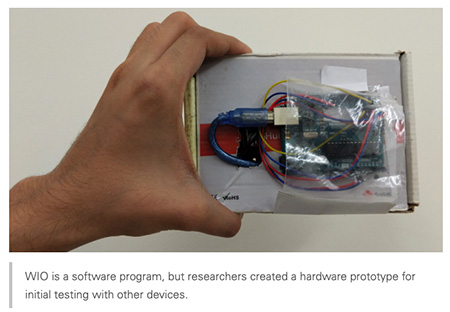CSC News
Using Wi-Fi Like Sonar to Measure Speed and Distance of Indoor Movement
For Immediate Release
Matt Shipman | News Services | 919.515.6386
Dr. Muhammad Shahzad | 919.515.8766
 Researchers
from North Carolina State University have developed a technique for measuring
speed and distance in indoor environments, which could be used to improve
navigation technologies for robots, drones – or pedestrians trying to find
their way around an airport. The technique uses a novel combination of Wi-Fi
signals and accelerometer technology to track devices in near-real time.
Researchers
from North Carolina State University have developed a technique for measuring
speed and distance in indoor environments, which could be used to improve
navigation technologies for robots, drones – or pedestrians trying to find
their way around an airport. The technique uses a novel combination of Wi-Fi
signals and accelerometer technology to track devices in near-real time.
“We call our approach Wi-Fi-assisted Inertial Odometry (WIO),” says Raghav Venkatnarayan, co-corresponding author of a paper on the work and a Ph.D. student at NC State. “WIO uses Wi-Fi as a velocity sensor to accurately track how far something has moved. Think of it as sonar, but using radio waves, rather than sound waves.”
Many devices, such as smartphones, incorporate technology called inertial measurement units (IMUs) to calculate how far a device has moved. However, IMUs suffer from large drift errors, meaning that even minor inaccuracies can quickly become exaggerated.
In outdoor environments, many devices use GPS to correct their IMUs. But this doesn’t work in indoor areas, where GPS signals are unreliable or nonexistent.
“We created WIO to work in conjunction with a device’s IMU, correcting any errors and improving the accuracy of speed and distance calculations,” says Muhammad Shahzad, co-corresponding author of the paper and an assistant professor of computer science at NC State. “This improvement in accuracy should also improve the calculations regarding a device’s precise location in any indoor environment where there is a Wi-Fi signal.”
The researchers wanted to test the WIO software but ran into a problem: they could not access the Wi-Fi network interface cards in off-the-shelf devices such as smartphones or drones. To address the problem, the researchers created a prototype device that could be used in conjunction with other devices.
The researchers found that using WIO improved a device’s speed and distance calculations dramatically. For example, devices using WIO calculated distance with a margin of error ranging from 5.9% to 10.5%. Without WIO, the devices calculated distance with a margin of error from 40% to 49%.
“We envision WIO as having applications in everything from indoor navigational tools to fitness tracking to interactive gaming,” Venkatnarayan says.
“We are currently working with Sony to further improve WIO’s accuracy, with an eye toward incorporating the software into off-the-shelf technologies,” says Shahzad.
The paper, “Enhancing Indoor Inertial Odometry with WiFi,” will be presented at UbiComp 2019, being held from Sept. 11-13 in London, U.K. The work was done with support from the National Science Foundation, under grant 1565609. Venkatnarayan will also be demonstrating WIO at ICNP 2019, being held in Chicago from Oct. 7-10.
-shipman-
Note to Editors: The study abstract follows.
“Enhancing Indoor Inertial Odometry with WiFi”
Authors: Raghav H. Venkatnarayan and Muhammad Shahzad, North Carolina State University
Presented: UbiComp 2019, Sept. 11-13, London, U.K.
DOI: 10.1145/3328918
Abstract: Accurately measuring the distance traversed by a subject, commonly referred to as odometry, in indoor environments is of fundamental importance in many applications such as augmented and virtual reality tracking, indoor navigation, and robot route guidance. While theoretically, odometry can be performed using a simple accelerometer, practically, it is well-known that the distances measured using accelerometers suffer from large drift errors. In this paper, we propose WIO, a WiFi-assisted Inertial Odometry technique that uses WiFi signals as an auxiliary source of information to correct these drift errors. The key intuition behind WIO is that among multiple reflections of a transmitted WiFi signal arriving at the WiFi receiver, WIO first isolates one reflection and then measures the change in the length of the path of that reflection as the subject moves. By identifying the extent through which the length of the path of that reflection changes, along with the direction of motion of the subject relative to that path, WIO can estimate the distance traversed by the subject using WiFi signals. WIO then uses this distance estimate to correct the drift errors. While researchers have previously proposed to use WiFi signals to correct drift errors, prior schemes suffer from one or more of the following six limitations: they 1) do not work indoors, 2) require manual exhaustive fingerprinting, 3) are not resilient against changes in environment including human movements, 4) do not work on commodity WiFi devices, 5) require multiple access points, and/or 6) can measure distance traversed by humans but not by non-human subjects. WIO addresses all of these limitations. We implemented WIO using commodity devices, and extensively evaluated it in a wide variety of complex indoor scenarios on both human and robotic subjects. Our results demonstrate that WIO achieved an average error of just 6.28% in estimating the distances traversed by the subjects.
This post was originally published in NC State News.
Return To News Homepage